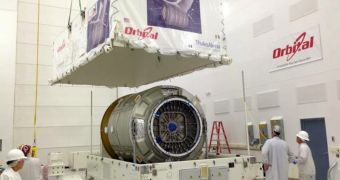Officials with Orbital Sciences Corporation (OSC), in Dulles, Virginia, announce that their second unmanned Cygnus spacecraft will be named for late NASA astronaut C. Gordon Fullerton (1936-2013).
The company will thus pay homage to the astronaut that helped deploy a series of air-launched rockets that OSC developed years ago. Fullerton died on August 21, 2013, following complications stemming from a stroke he suffered three years ago, Space reports.
Fullerton plays an important role at NASA, especially in the shuttle program. He was part of a series of taxi and flight trials of the prototype orbiter Enterprise, called ALT (Approach and Landing Tests). He also participated in shuttle Challenger's eighth mission (STS-51F) and shuttle Columbia's third mission (STS-3).
Before enrolling in NASA, in September 1969, Fullerton worked for the United States Air Force (starting in July 1958), and as a mechanical design engineer for the Hughes Aircraft Company, in Culver City, California. He was also a project pilot on numerous research programs at the NASA Dryden Flight Research Facility, at the USAF Edwards Air Force Base.
“We named our first Cygnus spacecraft to go to the space station the G. David Low, in honor of a former astronaut, a classmate of mine and former Orbital employee who was involved in the early days of COTS [Commercial Orbital Transportation Services] from the very beginning and who we lost a few years ago unfortunately,” says Frank Culbertson.
“Our next one, to continue the tradition, will be named for C. Gordon Fullerton,” adds the OSC official, who is a former NASA astronaut, and the executive vice president at the company. Fullerton's “connection with Orbital was that he was the pilot of the B-52 [swept-wing heavy bomber jet] that dropped our Pegasus [rocket] several times,” he explains.
The second OSC Cygnus spacecraft is scheduled to launch on a resupply mission to the International Space Station (ISS) on December 18, from the Mid-Atlantic Regional Spaceport (MARS). The launch facility is located at the NASA Wallops Flight Facility, on Wallops Island, Virginia.
OSC is scheduled to fly a series of 8 resupply flights to the space lab over the next few years, under a $1.9 billion (€1.38 billion) contract signed with NASA a few years ago. The first Cygnus launch was a demonstration, so the upcoming launch is the first mission in the series (Commercial Resupply Services-1, or CRS-1).
During this flight, the Cygnus capsule will carry nearly 1.5 tons of spare parts, experiments, equipment and supplies to the ISS. The spacecraft will be unloaded by the Expedition 38 crew currently aboard the space lab. After staying on the station for 42 days, the vehicle will be deorbited and destroyed in Earth's upper atmosphere.

 14 DAY TRIAL //
14 DAY TRIAL //